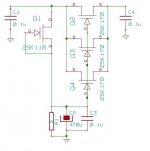john curl said:And I still can't enjoy CD in my car, because I find it annoying. Go figure. (Maybe, if people tried harder to make better sounding equipment, this would not be so?)
Except last week you said some CD's on the right players were good enough to demo equipment at the CES, make up your mind.
john curl said:44.1KHz was a complete Sony artifact. Even Phillips used 50KHz when I visited them in 1974. We used 50 KHz in 1968 at Ampex. Why?
Rumour has it that a Sony hoshot wanted to record a certain piece of music on a single CD, and that due to the length of the piece thaty had to go to 44.1k to make it fit. Could be just a rumour, but I've read it at several places.
Jan Didden
Joshua_G said:
Done:
Joshua,
You're almost there. Now lose all the FETs and everything east of it, and connect the opamp input to the top of C3. Real low noise! 😉
Jan Didden
john curl said:The Vendetta Research phono stage uses the 2sk146 (7) and the 2sj73 (4).
Unobtanium. So much for some oustanding engineering ideas.
Sleep well, you are safe.
😀janneman said:Now lose all the FETs
one should add, that you need a reliable pre-regulator, if you want to set the reference voltage by resistors only.
I don't trust the FET current source + resistor approach either.
But this could be a preconception of mine.
regards
In fact the debate about the audibility of pre-ringing has still not ended, but there are some hints that pre-ringing might indeed be a problem.
That´s the reason why some people think it could be a nice idea to return to asymmetric filter design, see for example Julian O. Smith.
Afair Lesurf too has written about some papers on this subject.
That´s the reason why some people think it could be a nice idea to return to asymmetric filter design, see for example Julian O. Smith.
Afair Lesurf too has written about some papers on this subject.
Jakob2 said:In fact the debate about the audibility of pre-ringing has still not ended, but there are some hints that pre-ringing might indeed be a problem.
That´s the reason why some people think it could be a nice idea to return to asymmetric filter design, see for example Julian O. Smith.
Afair Lesurf too has written about some papers on this subject.
I may be kicking in an open door here, but maybe we should remember that pre-ringing isn't. What happens is that the main signal peak is delayed and that what we think is pre-ringing is just the start of the signal, slowly (relatively) building up, with a delay, to the main peak.
I hope we can agree that this preserves the causality.
Jan Didden
janneman said:
Joshua,
You're almost there. Now lose all the FETs and everything east of it, and connect the opamp input to the top of C3. Real low noise! 😉
So, what will be quieter, 1 LME49720, or 3 2SK170 JFETs in parallel?
Juergen Knoop said:
one should add, that you need a reliable pre-regulator, if you want to set the reference voltage by resistors only.
I don't trust the FET current source + resistor approach either.
But this could be a preconception of mine.
The input is well regulated by LM317 and LDO following it.
Joshua_G said:
So, what will be quieter, 1 LME49720, or 3 2SK170 JFETs in parallel?
The noise at the Fet gate will always be smaller than the noise at the source.
Jan Didden
Joshua_G said:
So, what will be quieter, 1 LME49720, or 3 2SK170 JFETs in parallel?
Ahh, you're no longer using the opamp follower, then? I missed that.
Jan Didden
janneman said:
I may be kicking in an open door here, but maybe we should remember that pre-ringing isn't. What happens is that the main signal peak is delayed and that what we think is pre-ringing is just the start of the signal, slowly (relatively) building up, with a delay, to the main peak.
I hope we can agree that this preserves the causality.
Jan Didden
Normally pre-ringing and post-ringing is meant related to the main portion of the signal under observation.
It would be a nice concept, if my digital filters could begin to respond right before playing any signal. 🙂
Pre-ringing and post-ringing are a fundamental part of why the sampling theorem works. It is the ringing that bridges the gap between sampling points, allowing the original signal to be created.
janneman said:
Ahh, you're no longer using the opamp follower, then? I missed that.
Indeed, there is no longer an opamp.
P.S.
This is the final regulator (having regulation preceding it):
Attachments
I wonder whether a small resistor like 10R might be useful between C2, C3 and the gates of the 2SK170s to stop any possible oscillations between them ??
Patrick
Patrick
This regulator that Joshua_G has designed, is essentially what is used for the low noise regulator in the Vendetta Research SCP-1, 2 for that last 25 years, and it works pretty well, IF the load current is relatively constant. I use a Nichicon Muse or equivalent electrolytic cap in order to not have any magnetic leads on the cap(s) as well.
Well, it's not really a regulator in my book, it is a follower, but that may be semantics.
Question John, how do you set the Vout? Do you select Q1?
Jan Didden
Question John, how do you set the Vout? Do you select Q1?
Jan Didden
syn08 said:
So much for some oustanding engineering ideas.
Just use a bunch of 2N3055. Cheap, no oscillation problems there and really low base spreading resistance too 😀

Not joking now, I've seen this done once in a legit publication but I can't remember the ref.
Cheers,
Glen
- Status
- Not open for further replies.
- Home
- Amplifiers
- Solid State
- John Curl's Blowtorch preamplifier
